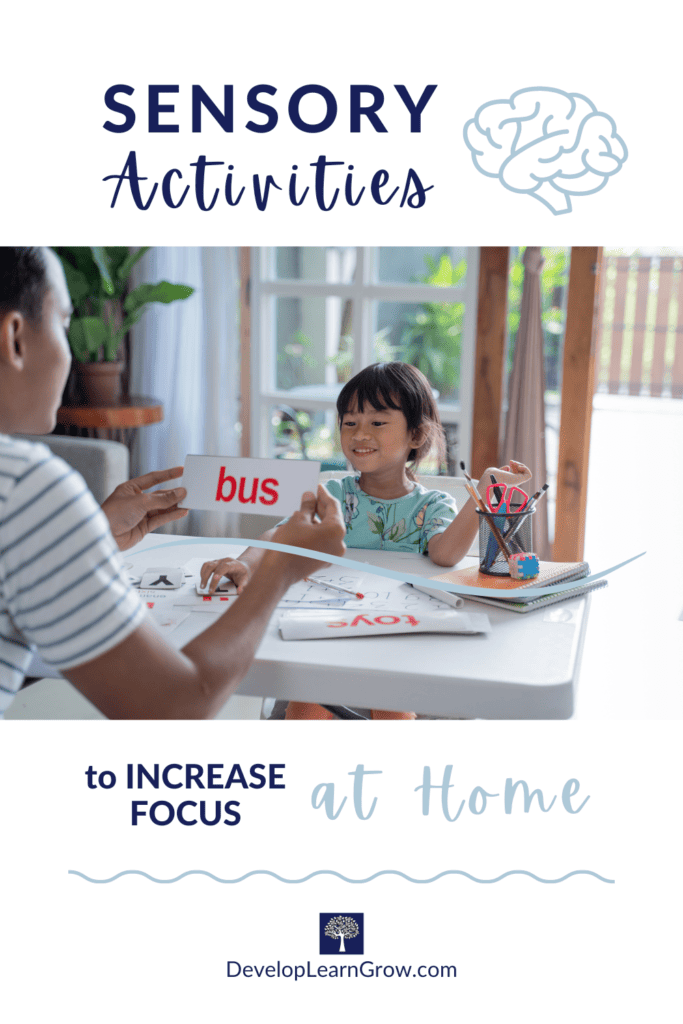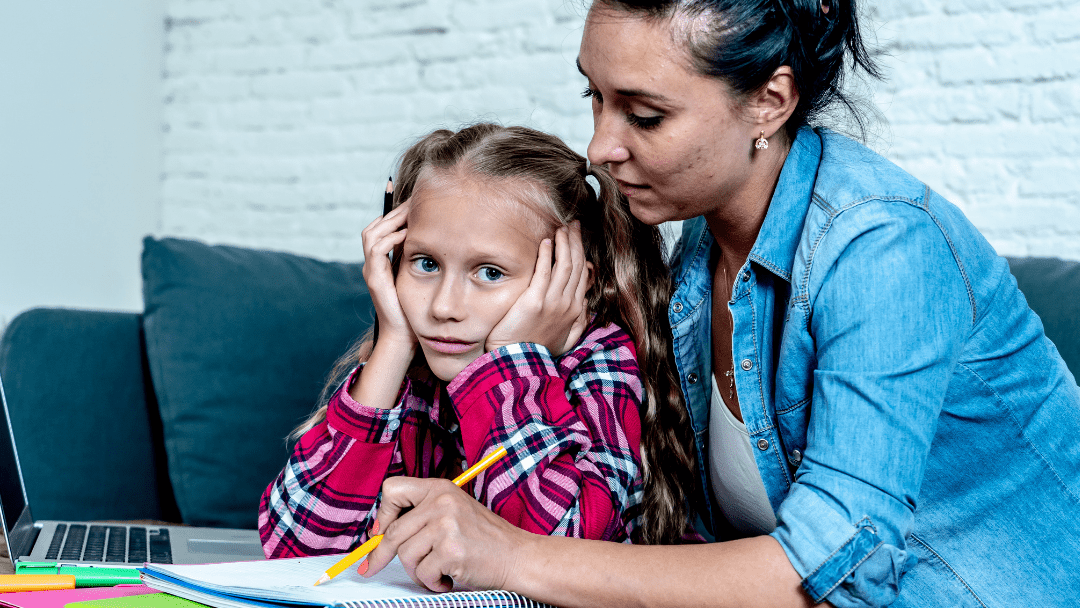Does your child have a hard time focusing on school work at home? These sensory diet activities from an occupational therapist give tips for the sensory systems as well as important considerations for the home environment. Find out what your child’s specific needs are so that you can help improve focus, behavior and learning!
Both adults and kids can have a hard time focusing. Either during work, during school or when at home completing work. There are simple sensory strategies that can help.
My sister had a temporary office job where she had to sit for long periods of time. She is not the type of person who enjoys being in the same spot all day. It drove her crazy. But worse than it being annoying, she was noticing fatigue and difficulty focusing.
She does not have a sensory processing disorder and she never had trouble with fatigue or focusing before!
As an occupational therapist, I couldn’t help but share some ideas for her own personalized sensory diet to help her focus!
Her sensory diet strategies included changing body position and stretching at various times during the day to give proprioceptive input.
It included vestibular input by taking frequent movement breaks for different tasks (refilling some of her water bottle and spacing out tasks that required getting up and walking somewhere – to the garbage can, to the copier, to another office, etc!)
She was also encouraged to sip ice water through a thin straw and she made sure her snacks were chewy or crunchy.
My sister was amazed at the difference! She was no longer feeling the fatigue and she could focus so much better. All from simply incorporating sensory strategies into her day!
Kids’ nervous systems are less mature. These strategies are helpful for adults, but they’re very powerful for children!
During remote learning, I had to use my skills as an occupational therapist to set up my home and create mini sensory diets for each family member. It was a little challenging since my husband, my three kids, and I all had different sensory preferences.
What is a Sensory Diet for Young Children?
The term sensory diet is used by an occupational therapist when referring to specific activities that provide sensory information to a child’s nervous system. The specific activities and sensory strategies are used to improve focus during daily tasks.
Creating a sensory diet involves finding what sensory activities a child’s body needs in order to improve attention, self-regulation, and behavior. When improvements are seen in these areas, kids can learn more optimally.
The word diet is used because the nervous system needs specific types of sensory input routinely at various intervals during daily activities. An activity can’t be tried just one time to see results. The input needs practiced several times throughout the day. Every day!
If you go on a nutritional diet, you wouldn’t see immediate changes after one day of eating a healthy salad for lunch and a light dinner, right? Eating healthy has to occur most of the time in your daily life for several weeks and months in order to see a difference.
The sensory activities that a child needs during daily tasks fuel the brain and nervous system – just as good food fuels our body systems and keeps us healthy.

Occupational Therapy Sensory Strategies and Sensory Diet Activities for Homework
Sensory activities provide a child’s central nervous system with important and necessary input. Kids’ brains learn through the body.
Every child’s sensory needs are different. Most kids need movement or vestibular input to help them learn and focus. Many children need input to the body’s muscles and joints (proprioceptive input) through heavy work and deep pressure activities.
Some kids need tactile input or fidgets to help them focus and remain regulated. Others need the right amounts of auditory input or visual input in order to prevent sensory overload.
Use the following sensory diet strategies and ideas at home to help your child focus.
Choose the ones that your child would benefit from to meet his/her specific needs.
The sensory activities and tips listed include vestibular and proprioceptive activities, oral sensory strategies, and visual and auditory activities, strategies and tips.
Sensory Input for the Vestibular System to Increase Focus at Home:
Movement play and exercise before learning is the most important thing kids need for their nervous systems. Kids’ bodies NEED MOVEMENT!
It provides nourishment for the body and brain. Movement and balance activities improve core strength and postural stability that support attention centers. The vestibular system works in the brain with the visual system and the eye muscles.
Movement input before learning increases focus. Short, quick movement breaks can be added to any homeschooling day or added in the evening before homework.
If your child is a mover, create a path for walking back and forth in a room or hallway (or even outside!) while reading or studying flashcards.
Outdoor time is great for movement but it also has tremendous benefits for the entire body and brain. The natural light, movement in large spaces, and clean air are especially great for the visual system. Make daily time for bikes, ball play, running, scooters, etc.
If long periods of homework are required, definitely schedule a few movement breaks and exercises (click for more vestibular activities.)
Sensory Input for the Proprioceptive System to Improve Attention for Homework:
Heavy work and deep pressure tasks are calming and organizing for the nervous system. These activities include climbing playground equipment, pushing furniture, stacking chairs, or pulling a weighted wagon or sled. Jumping (hopscotch) or using a trampoline are also great activities to perform prior to sitting down for homework.
Proprioceptive exercises, activities and stretches wake up the brain to improve attention to tasks. (Click the link for 25 easy exercises.)
Changing body position can help increase focus and attention. Have your child lie on the floor on the stomach for some tasks that don’t require writing or your child can stand to complete activities at a counter.
Consider flexible seating options to provide different changes in position. If neat handwriting is required, it’s best to have the table height around elbow level when the arms are resting at the sides. (Check Correct Sitting Posture for more tips.)
Weighted objects for the lap or shoulders can also improve focus. Calming Deep Pressure Weighted Tools and Activities has more ideas.
Thinking putty, kinetic sand, and stress balls can be used to give the hands deep pressure and tactile input.
Several specific hand fidgets are helpful as well! They can be as simple as a paper clip, or you can purchase fidget cubes, spinners, puzzles, gadgets, and more!
Oral Motor or Oral Sensory Input That Helps Increase Focusing at Home for Kids:
The mouth has so many sensory and motor receptors. Input to the jaw and mouth is very alerting and organizing for the nervous system.
Schools sometimes allow gum and hard (sugar-free) candies during tests because research has shown that it helps students to focus.
The jaw gets so much feedback with chewy and crunchy foods and snacks. There are several healthy options available!
Long, thin straws can also be used with thicker purees or with iced cold drinks. My sister can confirm that this works!
Sour or citrus flavors are extra alerting. Iced lemon water through a metal straw is also great to improve focus!
See Proven Oral Sensory Activities That Wake Up The Brain for more ideas.

Visual Strategies and Considerations During Homeschooling or Homework:
It’s important to make sure the room is bright and well-lit. A darker room can obviously make it hard for you to see but it also can decrease alertness and attention.
Decreased visual clutter in the work area can also help kids focus and decrease distractions.
It’s important to make sure your child is positioned to look directly at his/her homework with minimal distractions around. Movement in the room room or outside a window can be very distracting, especially to the sides.
Taking breaks or incorporating breaks that provide outside light and fresh air are important in re-focusing.
The natural light of day is extremely alerting for our bodies. If the weather does not cooperate, a bright window or glass door can help!
When screens absolutely have to be used for homework, it’s important to limit the time the eyes are looking at a screen (take a break after 20 minutes if possible to look at something distant – about 20 feet away… a change in location can also help visually.)
Please make sure you’re following screen use guidelines for all home activities.
Auditory Strategies and Considerations During Homeschooling or Homework:
Some kiddos can focus with other noises around them. Some CAN’T at all!
Music, talking, chanting out loud while learning is how some students need to absorb information. Some kids like to have background noise. They can tune out other noises around them.
For kids that need total silence when they complete homework, you’ll need a different set up or possibly some tools within your home.
Noise cancelling headphones are helpful (you can use adult ones meant for power tools.) Or find a child’s pair here.
White noise can help in a room if tolerated or by using a fan or a machine outside the door or the room where homework is being completed.
Classical music increases concentration without causing a distraction. It can also help create a rhythm when completing tasks.
Additional Information on the Sensory Systems and Sensory Diets
Pay attention to what strategies work for you and your child at home! Take all areas into consideration and find what works best for you.
The ideas shared in this post are to try with neurotypical children. If you suspect that your child has sensory processing difficulties that are interfering with their daily routines, consult your doctor for a referral for an occupational therapist so that you can get help and support for your child’s unique sensory processing needs.
For more information on Sensory Diets, Your Kid’s Table has sensory diet worksheet printables and templates for the home!
Pin this and other Develop Learn Grow posts on Pinterest so they’re easy to find!
In addition to the links embedded throughout the post, you might find these sensory articles helpful:
Sensory Systems 101 – Check out this post to further understand each of the sensory systems and find more activities.
The Pyramid of Learning – This post explains the importance of the sensory systems as the foundation for learning.
For a program full of sensory exercises with bonus fine motor skill development exercises:
Use these specific occupational therapy exercises to improve:
Attention… focus… core stability… crossing midline… sensory processing… visual development… & more… Click for more info!




0 Comments